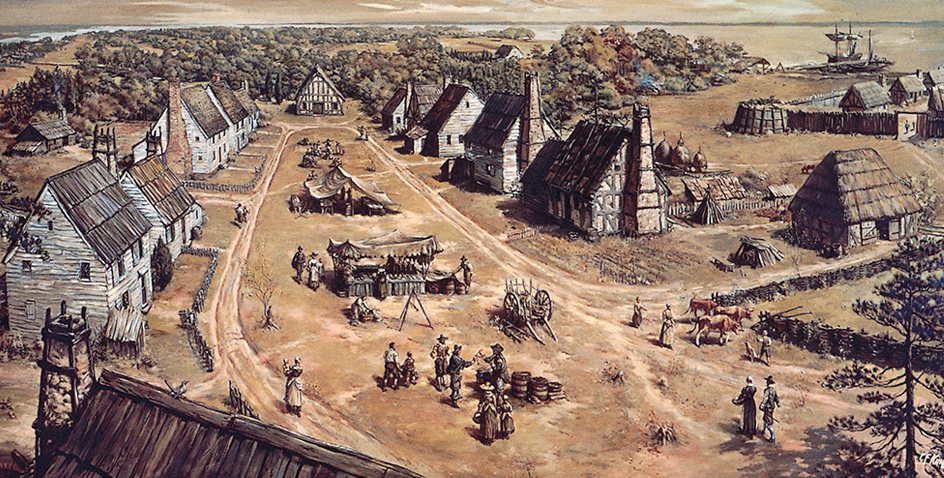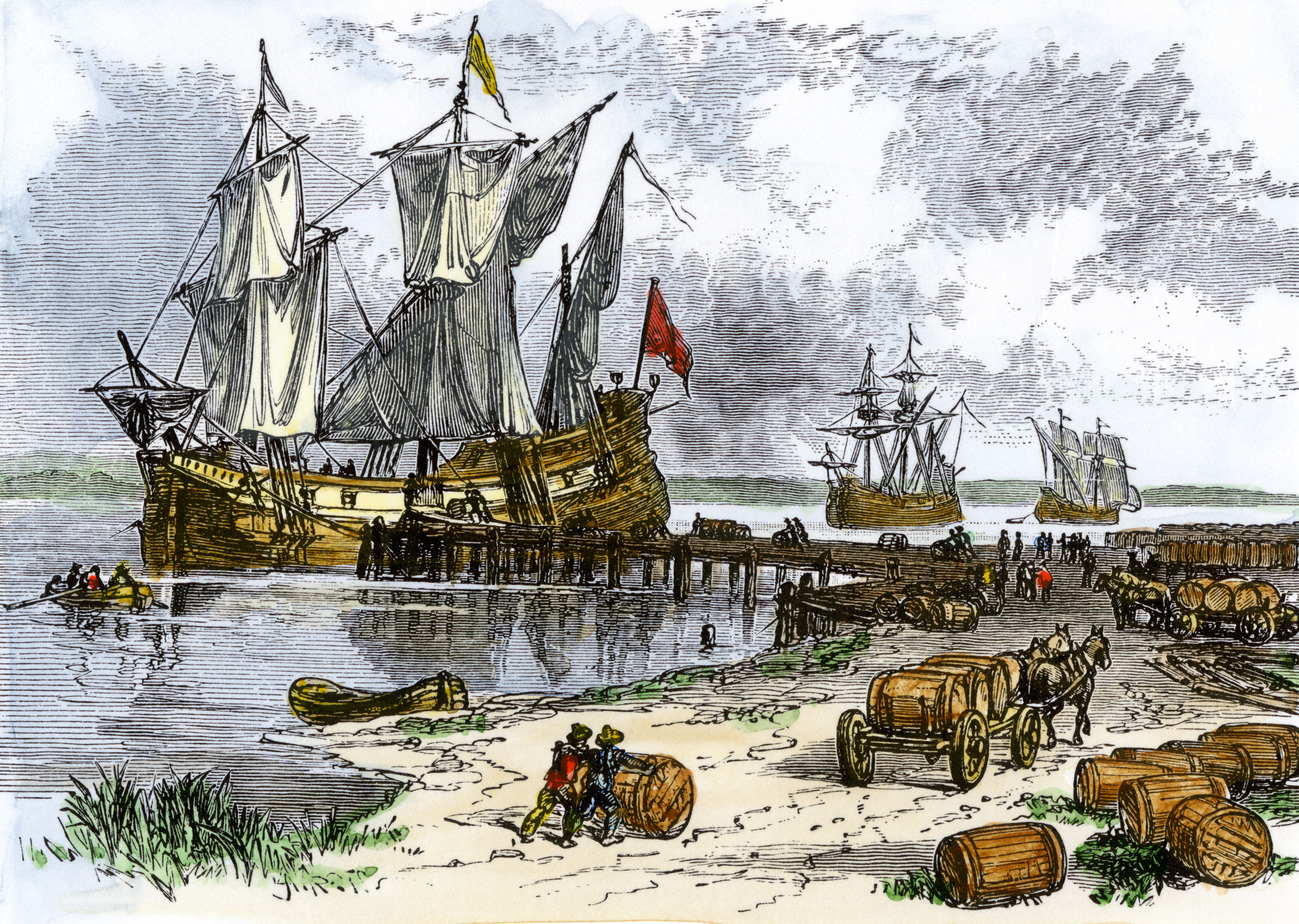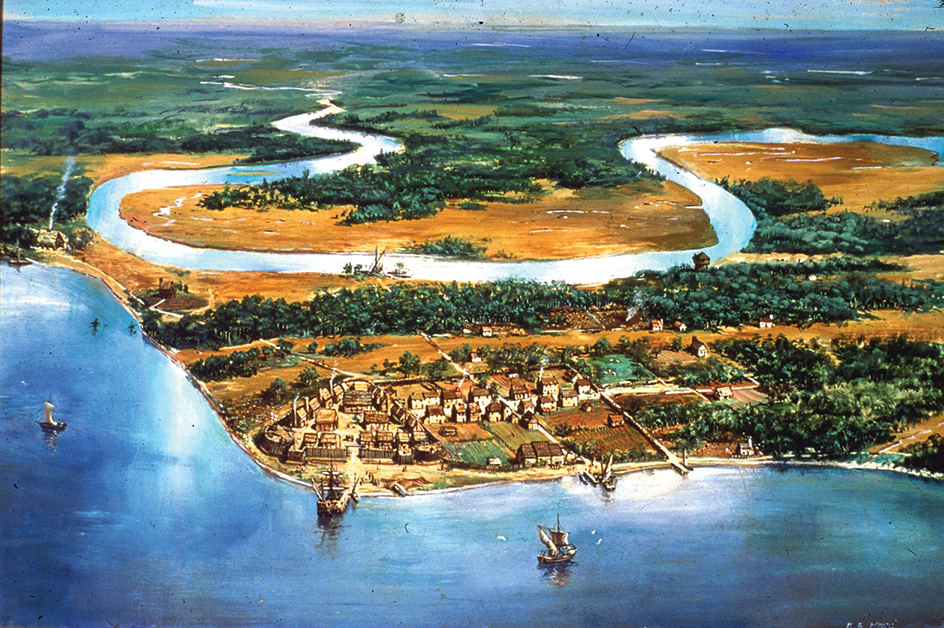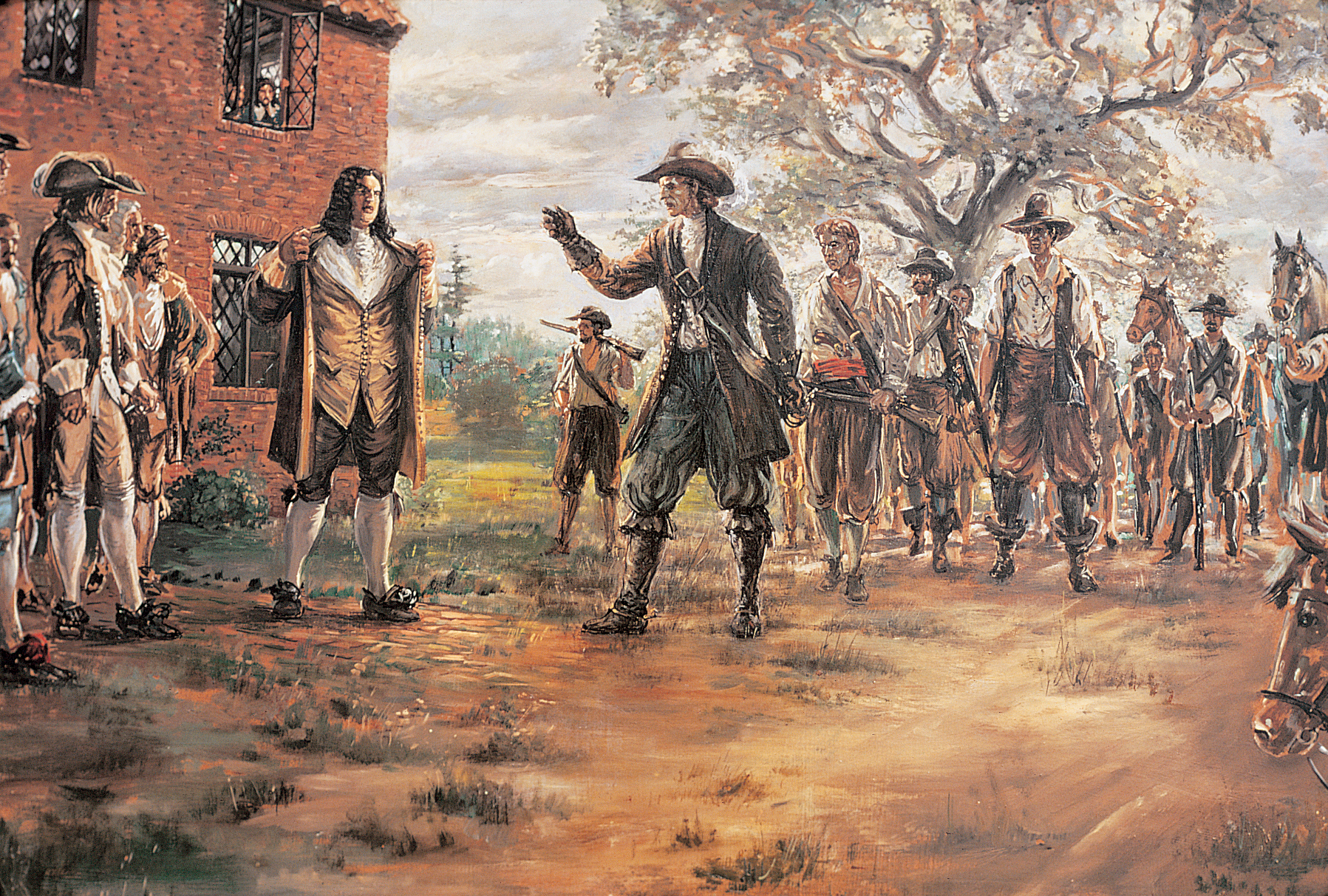Jamestown, Virginia, was the first permanent English settlement in North America. More than four months after leaving London, three ships arrived at the southern entrance of Chesapeake Bay, off what is now Virginia, on April 26, 1607 (May 6, 1607, according to the calendar now in use). The experienced seaman Captain Christopher Newport commanded the ships, the Susan Constant, Godspeed, and Discovery. The ships carried 104 colonists and 39 sailors.

The expedition was sponsored by a group of influential statesmen, gentry (important families), and London merchants known as the Virginia Company of London (see London Company). The purpose of the expedition was to set up a colony to establish England’s claim to the Chesapeake Bay region, search for gold or silver mines and a passage to the South Sea (Pacific Ocean), harvest the natural resources of the land, and trade with the Indigenous (native) inhabitants.
The colonists explored lands along the James River for a couple of weeks. On May 14 (May 24, according to the calendar now in use), they established themselves on a peninsula about 60 miles (97 kilometers) from the entrance of the Chesapeake Bay. They named the settlement Jamestown in honor of King James I of England. They had settled in a region ruled by a powerful chief named Powhatan (Wahunsonacock). Powhatan’s people also were known as the Powhatan. The domain of the Powhatan Confederacy stretched from south of the James River to the Potomac River, and included more than 30 tribes numbering approximately 15,000 people. 

The colony got off to a good start. Apart from a surprise Indigenous attack on Jamestown at the end of May, relations with the Powhatan people seemed promising. The colonists’ early explorations up the James River confirmed the area’s natural abundance. Information they gathered from Indigenous inhabitants hinted at great wealth to be found in the Piedmont Plateau and mountains to the west.
The settlers made themselves secure in a newly built triangular fort, and their future appeared rosy. But after Newport returned to London in June, the colony suffered a series of setbacks. During the summer and fall, a combination of disease, periodic Indigenous attacks, bad drinking water, and poor diet led to the deaths of about two-thirds of the men. By the winter, fewer than 40 of the original colonists who arrived at Jamestown survived. The colony was on the brink of collapse.
In 1608, the colonists were reinforced by more settlers and fresh supplies. They continued to search for valuable minerals and a river passage through the mountains that would lead them to the Pacific Ocean. That summer, Captain John Smith carried out two explorations of the Chesapeake Bay and its major rivers, which revealed the extensiveness of the region. Smith found no evidence of mines or a passage, however. In September, he took over leadership of the colony. He urged the colonists to stop searching for gold and silver and concentrate instead on producing goods to send to England.
Meanwhile, the London Company, reorganized and now led by the powerful merchant and financier Sir Thomas Smythe, attempted to undertake a thorough reform of the colony to attract new investors and make the venture profitable. The reforms emphasized strong leadership under a governor who would have sole command, the production of commodities marketable in England, continued efforts to find valuable minerals, and the conversion of the Powhatan to Christianity and English ways.
The arrival of several hundred more colonists during 1608 and 1609 led to a steady worsening in relations with the Powhatan. In the fall of 1609, Smith was badly injured and forced to return to England. War broke out soon afterward. In the winter, the Powhatan sealed off Jamestown in an effort to starve the colony into submission. During the siege, later called by colonists “the starving time,” Jamestown’s population dropped from about 250 to 60. Only the arrival in June 1610 of Governor Thomas West, Lord De La Warr, with 150 settlers saved the settlement from abandonment.
The war ended inconclusively in 1614. That year, Pocahontas, one of Powhatan’s favorite daughters, married John Rolfe, a prominent colonist. The English regarded the marriage as a diplomatic alliance. The union led to an uneasy truce between the two peoples.
Rolfe had experimented with the cultivation of tobacco, and he introduced a new type of tobacco from the Caribbean. His tobacco was sweeter than the native Virginia plant and more suitable to English tastes. The settlers found a rapidly expanding market for the tobacco in England. 
At the same time, the London Company, by now more commonly called the Virginia Company, encouraged the establishment of a number of other industries, including glass blowing, iron smelting, shipbuilding, and the making of potash, soap ashes, pitch, and tar. Settlers also produced a variety of timber goods. They attempted unsuccessfully to cultivate grapes for wine-making and mulberry trees for silk production.
In 1618, the company introduced sweeping reforms designed to replace the colony’s severe code of martial law with laws more like those of England. After land reforms made it easier to obtain private property, English settlement quickly expanded in the James River Valley. The newcomers displaced the Indigenous people who lived there. The following year, the first representative legislative assembly in the Western Hemisphere met in Jamestown’s church. The General Assembly served as a model for many of the lawmaking bodies in the American Colonies and, later, the United States (see House of Burgesses).
In 1619, a ship arrived in the James River with more than 20 Africans on board. The Africans had been captured by the Portuguese in what is now Angola and put on board a slave ship, St. John the Baptist, bound for Vera Cruz in Spanish America. The slave ship was captured by two privateers (private ships licensed to attack enemy vessels) in the Gulf of Mexico. One of the privateers, the White Lion, put into the James River and exchanged the Africans for provisions. Whether these Africans became enslaved or were made to work as indentured servants is not known. But tens of thousands of Africans, who would be enslaved to work in the tobacco fields, followed them over the years.
The spread of English settlement onto Indigenous lands led to another Powhatan uprising in 1622. Under Opechancanough, who had become the Powhatan’s leader after his older brother Powhatan died in 1618, Indigenous warriors attacked settlements along the James River. The Powhatan killed about 350 settlers—one-quarter of the colony’s white population. The settlers at Jamestown received warning of the uprising and managed to fend off Indigenous attackers advancing from the river. See Indian wars (Colonial days).
The uprising and further losses of life and property over the next year severely weakened the company, which collapsed in 1624 following a government investigation. However, the colony was taken under the authority of the English Crown and thrived. New Town, laid out just to the east of Jamestown’s fort, developed rapidly as a cluster of private dwellings, storehouses, and workshops where wealthy merchants, craftworkers, and public officials lived and worked. Demand for tobacco continued to grow. From the 1630’s, settlers began to pour into the colony. The enormous expansion of the tobacco trade during the 1600’s guaranteed Jamestown’s importance as a port and market. As the capital of the colony, the town was the center of government and political life.
Jamestown’s and the colony’s prosperity came to an abrupt halt in the mid-1670’s. The town burned to the ground in 1676 during Bacon’s Rebellion, a revolt against royal governor William Berkeley led by the planter Nathaniel Bacon (see Bacon’s Rebellion). Fire again destroyed many of the principal buildings in 1698. The latter disaster led to the transfer of the capital to Williamsburg the next year, and Jamestown fell into decay. 
Today, the Association for the Preservation of Virginia Antiquities (APVA) and the National Park Service of the United States jointly administer the site known as Historic Jamestowne, on Jamestown Island. The APVA owns the land west of the old church, including the site of the first fort, which was discovered in 1994 by a team of archaeologists led by William Kelso. Excavations have uncovered millions of artifacts, together with the outline of the fort and many of its structures.
The National Park Service manages the rest of the Island, including New Town, where the foundations of many buildings and artifacts belonging to the 1600’s town have been discovered. The Park Service also operates the parkway that connects Jamestown, Williamsburg, and Yorktown as part of the Colonial National Historical Park. In 2007, the United States commemorated the 400th anniversary of the founding of Jamestown.
